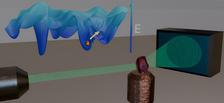Sketch of the experimental setup in the foreground with the glass sample in the middle. As an out-of-equilibrium material, the experimental and computational investigation of a glass is particularly difficult since their characteristics also depend on the specific thermal history which determines its energy, i.e. its position in the potential ‘energy landscape’ (in blue). (Credit: Jacopo Baglioni, Univ. of Padova)
How do photons interact with amorphous materials? A collaboration between scientists from the group of ‘Disordered Systems’ at the University of Padua and DESY Photon Science has unveiled how glasses prepared using different methods respond to irradiation with hard X-rays. The simultaneous study of the structural, dynamic and thermodynamic modifications induced by photons suggests that X-rays can generate an elasto-plastic transition in glasses. This research indicates a pathway to develop glasses that are insensitive to irradiation, a characteristic that is very important for the use of glasses in various fields ranging from material sciences to industrial applications. The findings were published in the journal ‘Reports on Progress in Physics’.
Although glasses are ubiquitous in our daily lives – houses without glass windows are hard to imagine - describing the glass transition and their properties remains one of the most challenging problems in condensed matter physics. As out-of-equilibrium materials, their experimental and computational investigation is particularly difficult since their characteristics also depend on the specific thermal history of the respective sample.
One particularity of glasses is the yielding transition which is typically studied by evaluating the response of the material to mechanical stress. However, the same state can also be achieved through the accumulation of plastic defects induced by interaction with high-energy photons. The yielding state is related to defects in the material and is of general interest in all applications where materials are subjected to stress. This new research explores the properties of the yielded state, emphasising its resilience to external stimuli.
A series of chalcogenide glasses (GeSe3) was investigated by using a flash differential scanning calorimeter installed at the PETRA III beamline P10 for Coherence Applications. The researchers could demonstrate that all glasses, regardless of their thermal history and stability, reach a unique state when irradiated at room temperature. Remarkably, this state is stationary, once attained. Although these glasses are more disordered and have a higher enthalpy than the annealed glass, the obtained properties are not extreme. They correspond to those of a glass that is immediately quenched from a temperature 20 % above the glass transition temperature. The state produced in this way remains unaffected by further irradiation, suggesting a similar phenomenology as under mechanical stresses. These results are consistent with how the glass responds to external stimuli. Pristine glasses behave as elastic media, while irradiated ones exhibit a plastic response.
These findings may lead to a paradigm shift. Traditionally, the pursuit of the most stable glass—one with minimal energy—has been driven by its exceptional entropic properties. However, the recent findings indicate that the yielded state, with its inherent stability, may offer potential for more applications. For instance, a glass in its yielded state appears to be an optimal choice for all environments like e.g. in space, where glasses must maintain their properties upon exposure to radiation.
Reference:
Uniqueness of glasses prepared via x-ray induced yielding, J. Baglioni, A. Martinelli, P. Sun, F. Dallari, F. Westermeier, M. Sprung, G. Grübel, G. Monaco, Rep. Prog. Phys. (2024), DOI: 10.1088/1361-6633/ad91df







